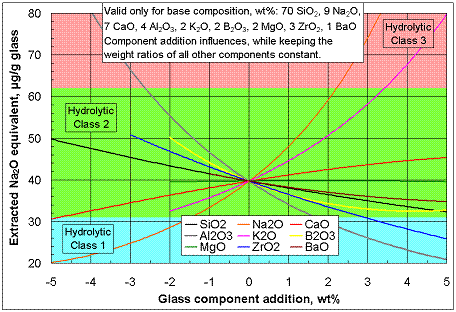
Influences of selected glass component additions on the chemical durability against water corrosion of a specific base glass; concentrations in percent by weight, wt% (click image to enlarge)
|
|
Calculation of the Chemical Durability (Hydrolytic Class, Corrosion) of Glasses
A model for the hydrolytic class (i.e., decadic logarithm of acid consumption in ml using procedure ISO 719) is now available (download calculator, 200 kB). It was developed by means of statistical analysis. Some interesting properties of the model are given here.
Number of data the model is based on = 561 (see source data references, 70 kB)
Degree of freedom = 529
R² = 0.9139
R²(adjusted) = 0.9088
R²(predicted) = 0.9012
Standard error = 0.1999
Mean of response (decadic logarithm of acid consumption in ml) = -0.6503
Main glass composition validity limits of the chemical durability model in mol%: SiO2 48-87%, Na2O 0-33%, CaO 0-30%, B2O3 0-22%, MgO 0-17.5%, ZnO 0-10%, Al2O3 0-18%, K2O 0-18%, SrO 0-2.5%, TiO2 0-21%, ZrO2 0-12%, BaO 0-12.5%, Li2O 0-9%, PbO 0-12.5%, F 0-5%, Fe2O3 0-2.5%, P2O5 0-4%, MnO 0-0.1%, Cl 0-0.3%, SO3 0-0.35%, Cr2O3 0-0.1%, SnO2 0-0.2%, As2O3 0-0.3%, Sb2O3 0-0.2%, CeO2 0-0.1%, NiO 0-0.01% (numerous additional model validity limits apply, considering glass component combinations).
The following spider-graph shows the influences of selected glass component additions on the chemical durability against water corrosion of a specific base glass, while keeping the molar ratios of all remaining components constant. The spider-graph will be different for other base glass compositions.

Influences of selected glass component additions on the chemical durability against water corrosion of a specific base glass; concentrations in percent by weight, wt% (click image to enlarge)
For the chemical durability model development, 12 outliers had to be excluded. Among these outliers, 3 are possibly inaccurate data that may be caused by phase separation. A list of the 3 possibly erroneous chemical durability data is provided here (20 kB).
The historic development of the chemical durability measurement accuracy over the years was investigated by analyzing the 561 model residuals, plus the residuals of the 12 outliers. In contrast to the error development for other properties it seems that the measurement accuracy increased in time as seen in the diagram below.
Historic measurement error development for the chemical durability of 573 silicate glasses (click image to enlarge)
For explanation of the increasing measurement accuracy one may take into account the possibility that the commercial interest in reliable chemical durability and corrosion data was very high espicially in recent times, which is reflected in a high number of reliable measurements. For many other properties, such as density, refractive index, or dispersion of common and specialty glasses, many commercially important measurements were conducted already several decades ago. Chemical durability measurement expertise seems to have developed only recently, in contrast to expertise about other glass properties. The topic needs further investigation.
The standard procedure ISO 719 is practically equivalent to the older procedures DIN 12111, TGL 14809, CSN 700531, and GOST 10134.1-82 (method A).
Procedure outline, ISO 719: 2 g glass, particle size 300-500 µm, is kept for 60 min in 50 ml de-ionized water of grade 2 at 98°C. 25 ml of the obtained solution is titrated against 0.01 mol/l HCl solution. The volume of HCl needed for neutralization is recorded and classified following the values in the table below.
|
0.01M HCl needed to neutralize |
Extracted Na2O |
Hydrolytic |
|
extracted basic oxides, ml |
equivalent, µg |
class |
|
to 0.1 |
to 31 |
1 |
|
above 0.1 to 0.2 |
above 31 to 62 |
2 |
|
above 0.2 to 0.85 |
above 62 to 264 |
3 |
|
above 0.85 to 2.0 |
above 264 to 620 |
4 |
|
above 2.0 to 3.5 |
above 620 to 1085 |
5 |
|
above 3.5 |
above 1085 |
>5 |
The procedure ISO 719 can be obtained from the International Organization for Standardization.
For practical application it must be considered that the procedure ISO 719 tests only the ability of water to extract soluble basic oxides, e.g., Na2O, K2O, BaO, or CaO, from glass by corrosion. Glasses that do not contain water soluble basic oxides must be tested by other procedures, such as based on weight loss analysis or base or acid resistance tests.